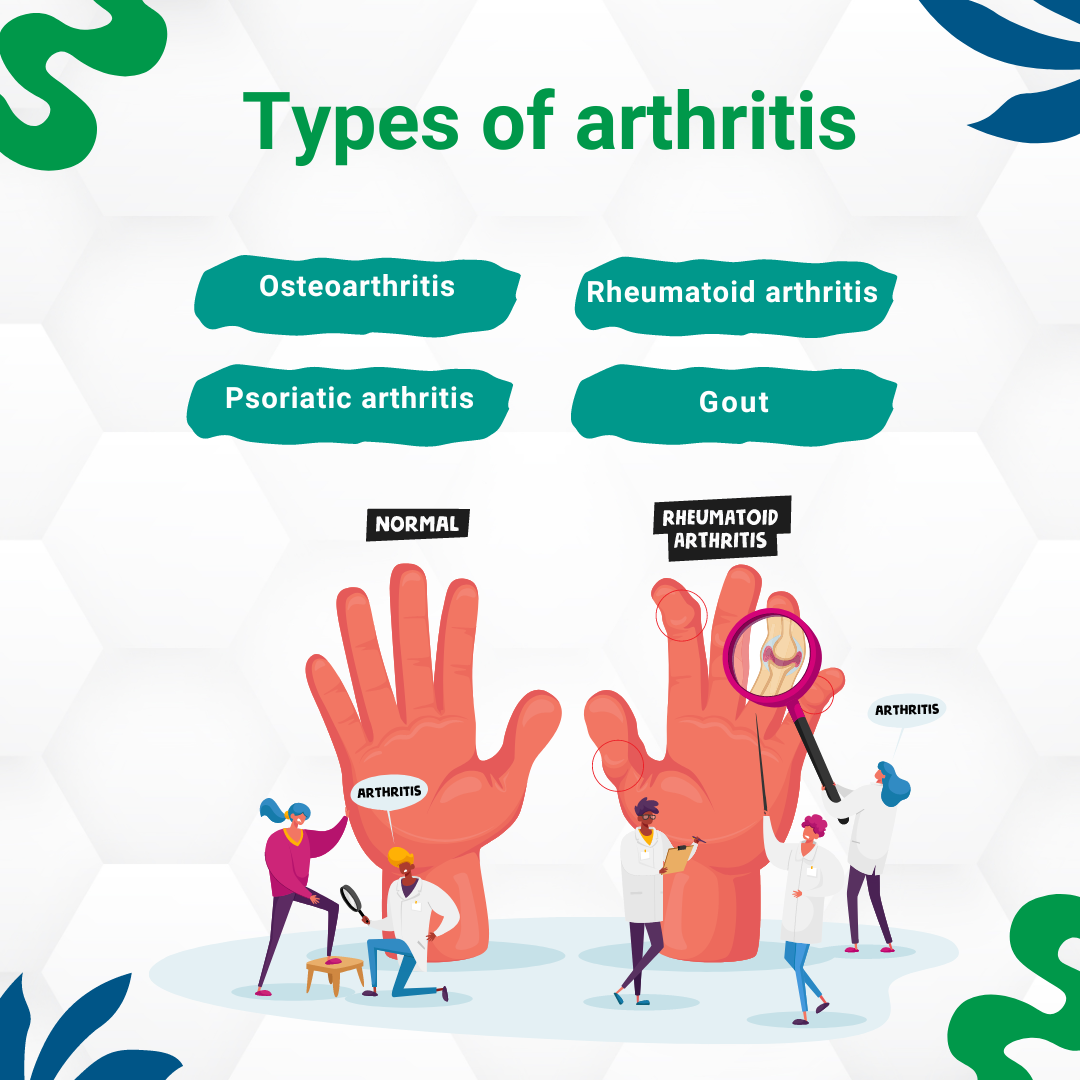
Types of Arthritis
Share
#Arthritis is a broad term used to describe inflammation of the #joints, causing pain, stiffness, swelling, and immobility. While commonly attributed to aging, arthritis can affect individuals of all ages and genders, including children. There are more than 100 types of arthritis, each with distinct causes, symptoms, and treatment approaches. Here, we explore five of the most common types of arthritis:
1. Osteoarthritis (OA):
#Osteoarthritis is the commonest type of arthritis, often referred to as “wear-and-tear” arthritis.
It occurs when the protective cartilage that cushions the ends of bones wears down over time.
This condition commonly affects joints in the hands, knees, hips, and spine.
Symptoms include joint pain, stiffness, especially after activity or prolonged rest, and decreased flexibility and mobility. Risk factors include age, obesity, joint injuries, and genetics.
Treatment focuses on pain management, physical therapy, nutrition, lifestyle changes, and in some cases, joint replacement surgery.
It is important to catch it early as the signs are quite visible. If early action is taken, the velocity of OA can be subdued with exercises, diets and nutrition.
2. Rheumatoid Arthritis:
Rheumatoid arthritis (RA) is an autoimmune disease where the body’s immune system mistakenly attacks its own joint tissues.
RA usually affects the joints symmetrically — if one hand or knee is affected, the other is likely to be affected as well. RA can also cause other symptoms such as fatigue, fever, and weight loss. Over time, it can progress and lead to joint deformity.
Treatment includes disease-modifying antirheumatic drugs (DMARDs), biologics, steroids, and physical therapy to manage inflammation and prevent joint damage.
There is also evidence that anti-inflammatory #diets have a positive effect in tempering RA. An anti-inflammatory diet for RA focuses on reducing inflammation by incorporating foods rich in omega-3 fatty acids, antioxidants, and other beneficial compounds. Key elements include fatty fish, fruits, vegetables, whole grains, and nuts, while limiting processed foods, red meat, and refined carbohydrates. #Nutrition rich in anti-inflammatory ingredients also shows tangible impact on RA.
3. Psoriatic Arthritis (PsA):
Psoriatic arthritis is associated with psoriasis, a skin condition characterized by red, scaly patches.
PsA can affect any joint and may also cause swelling in fingers and toes, nail changes, and eye problems. Many people with psoriatic arthritis also experience psoriasis, with symptoms like red, scaly patches on the skin, and changes in the nails, including pitting or thickening. In some cases, psoriatic arthritis can affect other organs, such as the eyes, leading to conditions like uveitis
The severity of joint damage in PsA can vary greatly.
Early diagnosis and treatment using anti-inflammatory drugs, biologics, and lifestyle modifications are essential to manage symptoms and prevent progression.
4. Gout:
#Gout is a form of inflammatory arthritis caused by the accumulation of uric acid crystals in the joints, leading to sudden and severe episodes of pain, swelling, and redness, often in the big toe.
This high uric acid level, also known as #hyperuricemia, can be caused by several factors, including dietary choices, certain medications, and underlying medical conditions. It is often linked to diet, alcohol consumption, and kidney function.
Treatment includes medications to lower uric acid levels and anti-inflammatory drugs to control flare-ups. Dietary changes also play a key role in managing gout. Consuming foods high in purines, like red meat, organ meats, and certain seafood, can increase uric acid levels. Excessive alcohol consumption, especially beer, can interfere with the kidneys' ability to eliminate uric acid, leading to its buildup. It is better to avoid these in case of gout.
5. Ankylosing Spondylitis (AS):
Ankylosing spondylitis (AS) primarily affects the spine, causing chronic inflammation in the spinal joints and leading to pain and stiffness, especially in the lower back. In severe cases, it can cause vertebrae to fuse, resulting in reduced flexibility and a hunched posture. Chronic back pain and progressive stiffness are hallmark symptoms, often worse in the morning or after periods of inactivity.
Over time, the inflammation can lead to the fusion of vertebrae, causing a stiff and rigid spine. Besides the spine, AS can also affect other joints, such as the hips, shoulders, knees, and ankles. In some cases, AS can cause systemic symptoms like eye inflammation (uveitis), fatigue, and skin rashes according to the US National Institutes of Health (NIH).
Treatment typically involves non-steroidal anti-inflammatory drugs, physical therapy, and biologic medications.
While arthritis can be painful and limiting, early diagnosis and targeted treatment can significantly improve quality of life. Understanding the different types of arthritis is crucial for selecting the right therapy and adopting lifestyle changes that support joint health. Regular exercise, maintaining a healthy weight, and a balanced diet rich in anti-inflammatory nutrients, maintaining the right postures, etc, can help manage symptoms across various forms of arthritis.
